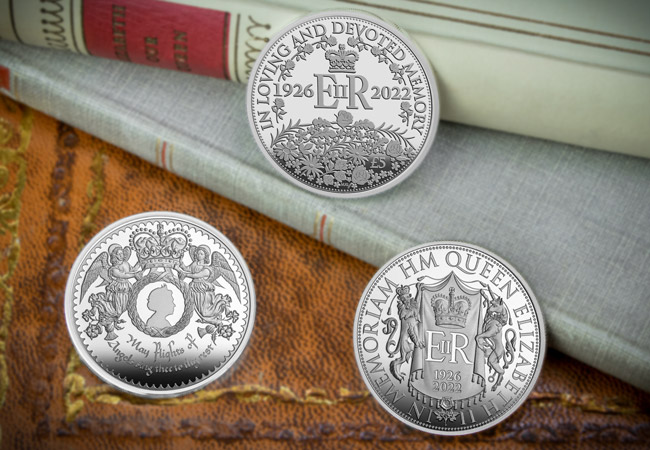Posts Tagged ‘Coins’
Crafting History in Art: Exclusive Interview with Steve Wyse – The Creative Mind Behind The History of British Railways £2 Sets
Prepare to be transported into the world of artistic ingenuity as we present a captivating interview with Steve Wyse, an esteemed Honorary Member of the Guild of Railway Artists. Join us in exploring the creative process, inspiration, and meticulous attention to detail that culminated in the exquisite designs gracing the freshly minted History of British Railways £2 Sets, creating a bridge between history and numismatic art.
Tracing Tracks: Unveiling the History of British Railways BU and Silver £2 Coin Sets
In the annals of British history, the year 1923 marks a pivotal moment that reshaped the nation’s railway landscape forever. A convergence of 120 regional railway companies gave rise to four prominent entities, as a result of the Railway Act of 1921.
Now, in a splendid tribute to this transformative event, special Brilliant Uncirculated and Silver Proof £2 Coin sets have been issued.
This extraordinary coin collection stands as a tribute to an era when steam and steel connected cities, fuelled the Industrial Revolution, and united the kingdom.
Click the circles below to find out more about the design and the sets:
Each gleaming £2 coin encapsulates the essence of a bygone era, immortalising five of the most iconic locomotives that once traversed the British countryside. Encased in special presentation packs, these coins are elevated by the artistic brilliance of Steve Wyse, an Honorary Member of the Guild of Railway Artists. Through his skillful renderings, the spirit of each locomotive comes alive, inviting you to relive the golden age of rail travel.
But for those who seek the pinnacle of numismatic excellence, we invite you to take a step further. Behold the History of British Railways Silver Proof £2 Coin Set—a masterpiece that merges history, artistry, and exclusivity.
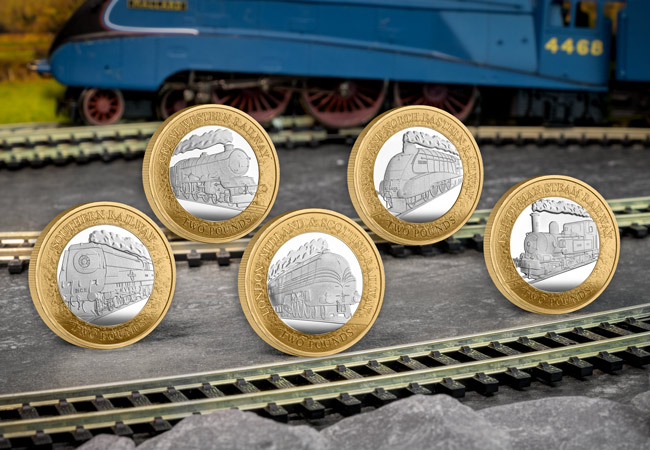
Limited to just 295 sets worldwide and meticulously struck from Sterling Silver, each coin has been crafted with precision and minted to perfection. These sterling silver coins are a stunning homage to the railway heritage.
Each coin is a portal to the past, an ode to innovation, and a salute to the journeys that shaped a nation. Choose your piece of history and become a guardian of the tracks that connect the past to the present.
Forever in Our Hearts: Queen Elizabeth II 2023 Memoriam Coins Unveiled
Her Royal Highness Queen Elizabeth II committed herself to a life of royal duty, earning the affection of generations here in the United Kingdom, across the Commonwealth, and around the world.
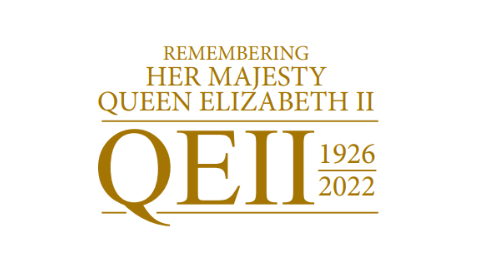
To preserve her majesty’s memory after her passing last year and the profound impact she made on countless lives, a breathtaking collection of memoriam coins has been unveiled – a testament to her tireless devotion to duty, and unwavering commitment to her people.
Each commemorative coin in this new collection serves as a token of remembrance – discover the intricate details and heartfelt symbolism woven into these coins.
View the key pieces below and delve into the depths of this magnificent collection.
Own the whole story with the In Memoriam Proof £5 Set
Introducing the 2023 British Isles ‘In Memoriam’ Proof £5 Set, a collection of three extraordinary coins commemorating the life and legacy of Queen Elizabeth II – featuring three £5 coins from Jersey, Guernsey, and the Isle of Man.
Strictly Limited to JUST 995 Collectors WORLDWIDE — That’s a tiny number for such an important anniversary and a sell-out looks guaranteed.
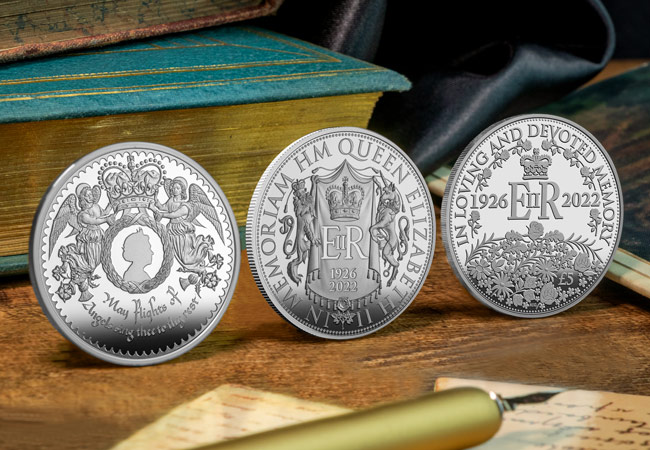
Own a piece of history with this extraordinary tribute to a beloved Queen by clicking here >>
A touching tribute with the Silver Proof £5
Meticulously crafted from sterling silver to a stunning Proof finish, this new £5 features an original design by specialist heraldry artist, Neil Bromley.
What is so poignant about this design is the quote from the Shakespearean play Hamlet, “May flights of Angels sing thee to thy rest” which were the touching words expressed by her son King Charles in his speech on September 9th, the day after he acceded the throne.
A reign to remember through the Silver Proof £5 set
In a heartfelt tribute to a reign which shaped history and touched countless lives, a British Isles Queen Elizabeth II ‘In Memoriam’ Silver Proof £5 Collection has been released, one year after Her Late Majesty’s passing.
Each coin has been officially approved by Buckingham Palace and has been struck from Sterling Silver to a pristine Proof finish.
Featuring three unique designs, this brand-new set honours Her Late Majesty’s extraordinary life, unwavering service and ever-lasting grace.
Click here to explore this limited-edition collection >>
A true gem for your collection – the stunning Silver 5oz
Struck from five ounces of Pure Silver, the 65mm diameter is the perfect way to show off this fantastic tribute.
Fully approved by Buckingham Palace, the Queen’s funeral wreath of symbolic flowers: Rosemary, Geraniums, Dahlias, English Oak, and Roses are wonderfully depicted.
The Inscription ‘In Loving and Devoted Memory’ is taken directly from the handwritten card that accompanied the wreath.
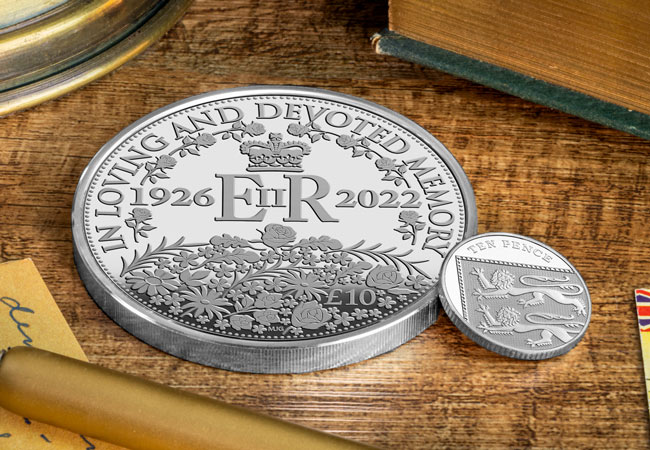
Click here to secure the prestigious Silver 5oz Coin for your collection >>
The Silver coin collection honouring the most iconic Jubilees of Queen Elizabeth II
Queen Elizabeth II acceded to the throne on 6th February 1952 and celebrated her Coronation on 2nd June 1953 at Westminster Abbey.
During her remarkable 70-year reign, Queen Elizabeth II enjoyed seven jubilees and was the first British monarch to receive a Platinum Jubilee.
And as we approach one year since her sad passing, just a handful of collectors will be able to preserve these remarkable milestones with four Silver coins…
Housed in one complete collection, you can secure the sought-after Silver Proof £5 coins issued by The Royal Mint to celebrate Elizabeth II’s Silver, Golden, Diamond, and Platinum Jubilees.
And considering how sought-after her commemoratives have become, here’s why you don’t want to miss out…
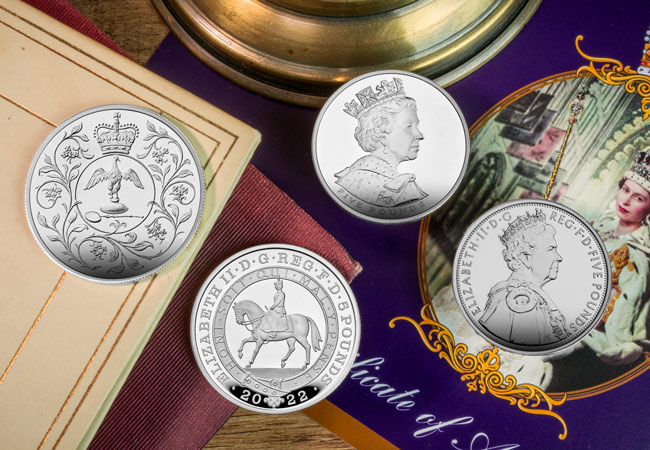
NO LONGER AVAILABLE AT THE MINT
Queen Elizabeth II’s influence on the collecting world has been immeasurable. And nearly a year after her sad passing, we are still witnessing excessive demand for commemoratives from her reign.
So today you can get ahead of the crowd and take a shortcut to securing four Silver Proof coins from her most significant Jubilees.
The release of Silver Crowns is renowned as the traditional way to celebrate historic royal occasions, and each one features a unique commemorative portrait of Elizabeth II either on horseback or a classic depiction of the young monarch.
But, 3/4 of these coins are no longer available to buy from The Mint, so this could be your last chance…

The UK Queen Elizabeth II Jubilee Silver Crown Collection
This exceptional set is essential for any collection. At a time more poignant than ever to collect Her Majesty’s commemoratives, this is the perfect way to preserve her extraordinary legacy…
Comprised of the UK Silver Proof £5 coins issued in celebration of her Silver, Golden, Diamond and Platinum Jubilee from 1977, 2002, 2012 and 2022, this complete collection takes you on a journey through the most remarkable milestones of our longest reigning monarch.
Housed in a luxury presentation box with a certificate of authenticity, this could be your last chance to secure these Silver coins as three of them are off-sale from The Mint…
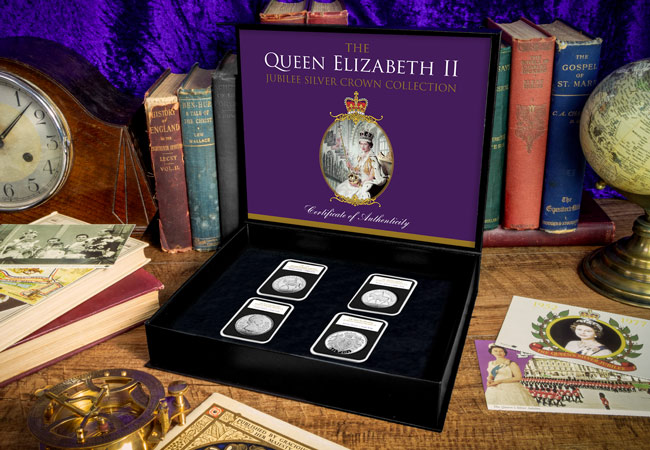
Your Last Chance?
Considering there is only one coin still available to buy from The Royal Mint, this could be your last chance to secure all of them in one complete pristine collection.
But considering Queen Elizabeth II collectables are scarcer than ever, this is the easiest way to secure the most sought-after Jubilee coins in with just a few clicks of a button!
However, only a tiny number of collections are available, so make sure you don’t miss out on securing such a rare set…
Click here to own your Queen Elizabeth II Jubilee Silver Proof £5 coin collection now >>


